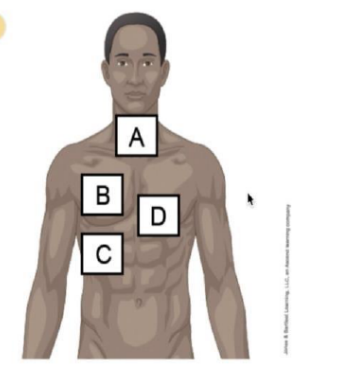ATI RN
RN-ATI-Fundamentals-of-Nursing-2023-2024 Questions
Extract:
Question 1 of 5
A nurse is caring for a client who is postoperative and refuses to use an incentive spirometer following major abdominal surgery. Which of the following actions is the nurse's priority?
Correct Answer: B
Rationale: The correct answer is B: Determine the reasons why the client is refusing to use the incentive spirometer. The priority is to assess the client's reasons for refusal to address any barriers preventing compliance, such as fear, pain, or lack of understanding. Understanding the client's perspective can help tailor interventions and address concerns effectively. Requesting a respiratory therapist (choice
A) or administering pain medication (choice
D) can be secondary once the client's reasons are identified. Simply documenting the refusal (choice
C) without addressing the underlying cause does not promote client-centered care.
Extract:
Nurses' Notes
1100: Client reports fever, chills, cough, and night sweats for past 2 weeks. Client has recently traveled outside of the country. Lethargic, but oriented to person, place, and time. Crackles heard in lower lobes of lungs upon auscultation. Cough is productive with small amounts of blood. Reports tightness in chest and pain when coughing. Reports losing 5 Ib in the last week. Has no appetite and is nauseated. Obtained blood work, chest x-ray, and sputum cult
Question 2 of 5
The nurse is placing the client on isolation precautions. Which of the following interventions should the nurse include? Select all that apply.
Correct Answer: B
Rationale: The correct answer is B: Place a container for soiled linens inside the client's room. This intervention is important to prevent the spread of infection. Placing a container for soiled linens inside the client's room ensures that contaminated linens are contained and not mixed with other linens, reducing the risk of transmitting the infection to others.
Rationale for why other choices are incorrect:
A: Wearing an N95 mask is not necessary unless the client has airborne precautions, such as tuberculosis.
C: Placing the client in a negative airflow room is typically reserved for clients with airborne infections to prevent the spread of droplet nuclei in the air.
D: Removing the mask after exiting the client's room is incorrect as the mask should be removed before exiting to prevent contamination outside the room.
In summary, choice B is correct as it directly addresses infection control measures related to soiled linens, while the other choices are not relevant to isolation precautions or are incorrect based on standard
Extract:
Question 3 of 5
A client who is postoperative is verbalizing pain as a 2 on a pain scale of 0 to 10. Which of the following statements should the nurse identify as an indication that the client understands the preoperative teaching she received about pain management?
Correct Answer: C
Rationale: The correct answer is C: "It might help me to listen to music while trying to sleep." This answer indicates that the client understands the preoperative teaching about pain management, as distraction techniques such as listening to music can help manage pain perception. Listening to music can be a non-pharmacological method to alleviate pain and promote relaxation.
Choices A and D indicate a lack of understanding as they suggest inappropriate responses to pain.
Choice B suggests a distraction technique but not the most effective one.
Choices E, F, and G are not provided, but based on the context, they would likely be irrelevant or incorrect in the context of pain management.
Extract:
Laboratory Results 1200: Hgb 9.5 g/dL (14 to 18 g/dL)
Hct 38% (42% to 52%) Bilrubin 5.3 mg/dl (0.3 to 1.0 mg/dL) [ instruct the client to avoid blowing their nose forcefully.
Creatinine 1.8 mg/dL (0.6 to 1.3 mg/dL) [ Assess the dlent’s level of oientation
Platelet count 100,000/mm? (150,000 to 400,000/mm?)
[ Place the client under contact isolation.
1800:
Alanine aminotransferase ALT 51 units/L (4 to 36 units/L) Aspartate aminotransferase AST 48 units/L (0 to 35 units/L)
Alkaline phosphate ALP 151 units/L (30 to 120 units/L) Blood total protein 15 g/dL (6.4 to 8.3 g/dL
Question 4 of 5
A nurse is caring for a client who has been admitted to the hospital. Select the 5 actions the nurse should take?
Correct Answer: A,B,C,E,F
Rationale: The correct actions for the nurse to take are A, B, C, E, and F. Providing rest periods (
A) promotes healing and recovery. Restricting sodium intake (
B) is important for certain conditions like hypertension. Advising the client to avoid soap and alcohol-based lotions (
C) can prevent skin irritation. Instructing the client to avoid blowing their nose forcefully (E) prevents potential harm to nasal passages. Assessing the client's level of orientation (F) is crucial for monitoring mental status and detecting any changes. These actions prioritize the client's well-being, safety, and overall health.
Extract:
Question 5 of 5
nurse is auscultating for crackles on a client who has pneumonia. Which of the following anterior chest wall locations should the nurse auscultate? (You will find hot spots to select in the artwork belowi. Select only the hot spot that corresponds to your answer.)

Correct Answer:
Rationale:
Correct
Answer: B
Rationale: Crackles in pneumonia are typically heard in the lower lung fields due to fluid accumulation. Auscultating at location B (lower anterior chest wall) allows for better detection of crackles in the bases of the lungs where pneumonia commonly affects. This area corresponds to the lower lobes where consolidation occurs, leading to crackles. Auscultating at other locations (A, C,
D) may not yield clear crackle sounds associated with pneumonia.
Summary of other choices:
A (Location A - upper anterior chest wall): Crackles in pneumonia are typically heard in the lower lung fields due to fluid accumulation.
C (Location C - middle anterior chest wall): Crackles in pneumonia are not typically heard in the middle lung fields.
D (Location D - upper lateral chest wall): Crackles in pneumonia are not typically heard in the upper lateral chest wall.
